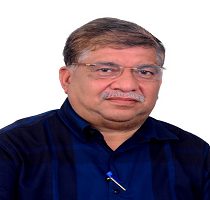Organizing Committee

Name : Dr. Deepak Sharma
University : Indira Gandhi Krishi Vishwavidyalaya, Raipur, India.
Country : India
Abstract
Rice (Oryza sativa L) is one of the most indispensable cereals and Chhattisgarh recognized as “Rice Bowl of India” has worlds’ second largest rice germplasm collection of 23250 rice accessions maintained at gene bank by Indira Gandhi Krishi Vishwavidyalaya, Raipur. Dr. R.H. Richharia, a renowned rice scientist, have documented indigenous technical knowledges (ITKs) regarding the medicinal uses of selected traditional rice varieties of the collection. Validation of these ITKs is essential for the implementation of rice based therapeutic applications “Rice Therapy”, a concept proposed by Dr. R.H. Richharia.
Under joint collaboration of IGKV and Bhabha Atomic Research Centre, Mumbai (BARC), efforts were made to validate medicinal properties of some of these traditional varieties through scientific research. Sanjeevani Rice, a pureline selection of germplasm accession of IGKV, Raipur, upon consumption of its brown rice exhibited immune boosting activity through enhancing the clearance of bacteria and dead cells by a type of immune cells called macrophages. The LCMS studies on Sanjeevani brown rice showed seven known Nrf2 activator -Trysol, DL-Carnitine, Coumarin, Arachidonic acid, 4- Coumaric acid, Adenosine, Vanillin, which activate the Nrf2 pathway exhibiting the immune boosting property. Methanolic Gathuwan Brown Rice Extract, an indigenous rice variety of Chhattisgarh, exhibited T-cell activation, proliferation and cytokine secretion (IL-2, IL-4, IL-6 and IFN-γ). Gathuwan suppressed T-cell-mediated immune responses by altering the cellular redox balance and activating the Nrf2 signalling pathway. Maharaji rice, an aromatic variety studied using Liquid Chromatography Tandem Mass Spectrometry (LCTMS) analysis exhibited various bioactive compounds including terpenes, flavonoids, and amino acids exhibiting exhibited potent radical scavenging activity. Methanolic brown rice extract of Gudma Dhan exhibited potent antioxidant properties and showed anti-inflammatory activity by inhibiting the secretion of IL-2, IL-4, IL-6, and IFN-γ cytokines in lymphocytes and the secretion of nitric oxide, IL-1β, TNF-α, and IL-6 cytokines in macrophages. The mutant variety of the same exhibited similar bioactive efficacy as the parent variety, indicating non-significant metabolomic diversification due to mutation breeding. Gudma Dhan and its mutant possessed abundant bioactive metabolites and exhibited potent antioxidant and anti-inflammatory properties compared to non-pigmented brown rice extract.
Keywords: Medicinal Rice, LCMS, Nrf2 Activators, Chhattisgarh germplasm, Indigenous technical knowledge (ITK).
Biography
Dr. Deepak Sharma is working as Head of the Department of Genetics and Plant Breeding, IGKV, Raipur. He got his under graduate degree in Biology form Jabalpur University in 1982. He obtained his post-graduate and Ph.D. degrees in Plant Breeding and Genetics from Jawaharlal Nehru Krishi Vishwavidyalaya, Jabalpur during 1985 and 1998. Dr. Sharma had joined the Department of Genetics and Plant Breeding of IGKV as Assistant Professor in 1996 and became Head of the Department in 2021. He has more than 35 years of experience in research/academia in the field of agricultural sciences/plant breeding/crop improvement. Dr. Sharma had handled 14 national and international funded projects on crop improvement. During this time, as the main breeder, he has developed two rice hybrids viz, “Indira Sona” and “Chhattisgarh Hybrid Rice-2”; one aromatic, nutritive and red rice variety suitable for poha “Chhattisgarh Dhan Barhasal Sel-1”; six high yielding rice mutant varieties viz, TCDM-1, Vikram-TCR, CGJT, TCVM, TCSM, Bauna Luchai CTLM; and India’s first rice variety with medicinal properties “Sanjeevani Rice”. Additionally, he has also contributed to the development of 15 rice varieties as supporting breeder and team member.
He has worked as nodal officer of PPV&FRA for conservation and utilization of crop biodiversity, during which he has facilitated the submission of 1868 farmers’ varieties applications for registration under PPV&FRA. Among them, registration certificates of 561 landraces / varieties of various crops have been received. Additionally, he has facilitated in securing geographical indicators for two popular traditional rice varieties i.e., Jeeraphool and Nagri Dubraj. He has also facilitated farmers’/farmers’ communities of Chhattisgarh in receiving 19 Plant Genome Saviour Awards of PPV&FRA.

Name : Estefânia V.R. Campos
University : Institute of Science and Technology, São Paulo State University (UNESP)
Country : Brazil
Abstract
Climate change, driven by human activities, poses a significant threat to plant survival due to its immobility and vulnerability to environmental instabilities (El Sabagh et al., 2022). Additionally, excessive agrochemical use contaminates natural soil resources, further hindering plant growth (Fraceto et al., 2016). Mitigating climate change and environmental degradation is a pressing challenge to find sustainable solutions to increase global food production while preserving the environment (Zeng et al., 2021). Whether natural or synthetic, plant growth regulators (PGRs) offer a promising avenue for enhancing plant resistance to various stresses. Applied at low concentrations, they play a pivotal role in regulating hormonal balance and signaling networks, impacting plant growth, development, metabolism, and stress responses (Iqbal et al., 2022). PGRs encompass phytohormones, their precursors, analogs, and substances that modulate hormone biosynthesis, inactivation, translocation, or signaling pathways (Rademacher, 2015). PGRs find wide-ranging applications in agriculture, horticulture, and ecological restoration, offering benefits
like improved plant growth, increased crop yield and quality, and enhanced resistance to biotic and abiotic stresses. However, challenges include their short shelf-life and low stability in the field, compromising their effectiveness (Jiménez-Arias et al., 2020). Nanoencapsulation by green synthesis of PGRs emerges as a promising strategy to address these challenges by protecting PGRs
from premature degradation, prolonging their shelf-life, and promoting sustained release. Additionally, it enables targeted delivery of PGRs to specific plants, enhancing uptake and translocation (Campos et al., 2023). Field studies have shown that seed priming with chitosan nanoparticles improves plant development and yield, with gibberellic acid-loaded nanoparticles significantly boosting tomato production (Pereira et al., 2019). Biostimulant formulations have the potential to revolutionize agronomic and ecological approaches, enhancing plant resilience, survival, and productivity in diverse contexts.
Biography
Estefânia Vangelie Ramos Campos holds a Bachelor’s degree in biotechnology from the University of Sorocaba and has attained both her Master’s and Ph.D. qualifications in Functional and Molecular Biology from the University of Campinas. She is a postdoctoral researcher at the Institute of Science and Technology of Sorocaba – UNESP. In addition to her academic pursuits,
she is a co-founder of the startup B.nano, actively contributing to research, development, and innovation endeavors focused on creating micro/nanoparticulate systems designed for the transport of bioactive molecules. Her scholarly pursuits primarily center on the development of carrier systems for the sustained release of agrochemicals, biopesticides, and pharmaceuticals, as well as
the comprehensive investigation of their biological activity, mechanisms of action, and potential toxicity to non-target organisms. Dr. Campos boasts an impressive academic portfolio comprising 58 scientific articles (more than 8000 citations and h-index 32), 1 organized book, 5 contributed book chapters, and active involvement in patent applications.

Name : Mansour A. Abohatem
University : Department of Biology, Faculty of Applied Sciences, Amran University, Yemen.
Country : Yemen
Abstract
Somatic embryogenesis is one of the most important techniques for micropropagation of date palm, but somatic embryogenesis via solid culture media is constrained with low proliferation rate. Recently, considerable progress has been made in the development and improvement of this technique via cell suspension cultures, which has shown rapid and large proliferation potentials in date palm somatic embryos production. Our previous study fully described an efficient plant regeneration protocol of date palm via somatic embryogenic suspension cultures starting from shoot tip explants to plants acclimatization (Abohatem et al., 2017). In the current study, the growth stages of embryogenic cell suspension cultures of date palm are described. The detailed morphological observations have revealed that the cells of suspension cultures divided actively and formed large spherical embryos (globular stage) within 2th and 3th week, the globular embryos start to conversion to elongated embryos in the 3th week and continues until to 5th week, the cotyledonary embryos formed within the 5th and 6th week.
Cell suspension cultures is the most promising method for produce commercially bioactive compounds such as phenolic compounds of high antioxidant value, which possess anticancer properties and to prevent cardiovascular diseases. To increase the biosynthesis of phenolic compounds on the large-scale using elicitors in cell suspension cultures, we studied the effect of activated charcoal and subculture rates on phenolics accumulation in date palm somatic embryogenic suspension cultures. Addition of activated charcoal at 0.15% improved growth rate of somatic embryos and decreased phenolics accumulation and peroxidase activity, whereas the culture medium without charcoal has significantly increased phenolics accumulation and peroxidase activity in comparison with medium with charcoal. The high rate of subcultures every 7 days showed a substantial increase in the proliferation of embryogenic cells and reduction of tissue/cell oxidative browning, which associated with low phenolics content and peroxidase activity. The low rate of subcultures every 15 or 20 days showed a significant increase in the phenolics content and peroxidase activity in plant tissue led to an enhancement of tissues/cells browning and then a decreased in the proliferation of embryogenic cells. These results will contribute to a reliable protocol for the commercial production of phenolic compounds that are the basic materials for several pharma and food industries.
Biography
Dr. Mansour A. Abohatem is an Associate Professor of Botany in Faculty of Applied Sciences, Amran University, Yemen. He obtained his BSc degree (Horticulture) and MSc degree (plant biotechnology) from the University of Cairo, Egypt., and Ph.D. degree (plant biotechnology and mycorrhiza fungi) from Cadi Ayyad University, Faculty of Sciences, Marrakesh, Morocco in 2012. He has authored about 12 research papers in a number of major international journals, book series, and international conferences. He has authored 2 books and his second book has been republished and translated into eight other languages. He has managed and established the laboratory of plant tissue culture at Ministry of Agriculture & Irrigation in Yemen, which provide high quality production of the date palm, potato, strawberry, banana and roses. He has strong experience in train and supervise on all stages of plant tissue culture laboratory. Now, he works to establishment his laboratory private for commercial production of date palm, potato and other plants. His future research interests focus in the field of using plant cell suspension technique for production of secondary metabolites, like, pharmaceuticals, antioxidants.
